Arlene Louise Croce (born May 5, 1934) is an American dance critic. She founded Ballet Review magazine in 1965. From 1973 to 1998 she was a dance critic for The New Yorker magazine.
Arlene Louise Croce (born May 5, 1934) is an American dance critic. She founded Ballet Review magazine in 1965. From 1973 to 1998 she was a dance critic for The New Yorker magazine.
Prior to Croce's long career as a dance writer, she also wrote film criticism for Film Culture and other magazines. The keynote of her criticism can be grasped from her ability to evoke kinesthetic movement and expressive images in her writing. Although she considers ballet to epitomize the highest form of dance, she has also written extensively on the topic of popular and filmed dance, and is a recognized authority on the Astaire and Rogers musical films.
In 1994, she courted controversy with her stance on Bill T. Jones's Still/Here , a work about terminal illness. In an article called "Discussing the Undiscussable," [1] she dubbed the work "victim art" and refused to attend any performances, claiming that it was "unreviewable." The article was reprinted in her 2000 book, Writing in the Dark.
Her writings on dance are available in several books, and a sampling of her film criticism can be found in the anthology American Movie Critics:An Anthology From the Silents Until Now. A review of her The Fred Astaire & Ginger Rogers Book can be found in Pauline Kael's collection of movie reviews, Reeling .
Incomplete - to be updated
| Library resources about Arlene Croce |
| By Arlene Croce |
|---|

The Gay Divorcee is a 1934 American musical film directed by Mark Sandrich and starring Fred Astaire and Ginger Rogers. It also features Alice Brady, Edward Everett Horton, Eric Blore, and Erik Rhodes. The screenplay was written by George Marion Jr., Dorothy Yost, and Edward Kaufman. It was based on the Broadway musical Gay Divorce, written by Dwight Taylor with Kenneth S. Webb and Samuel Hoffenstein adapting an unproduced play by J. Hartley Manners.
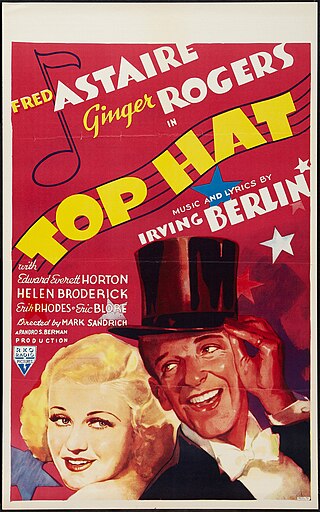
Top Hat is a 1935 American musical screwball comedy film in which Fred Astaire plays an American tap dancer named Jerry Travers, who comes to London to star in a show produced by Horace Hardwick. He meets and attempts to impress Dale Tremont to win her affection. The film also features Eric Blore as Hardwick's valet Bates, Erik Rhodes as Alberto Beddini, a fashion designer and rival for Dale's affections, and Helen Broderick as Hardwick's long-suffering wife Madge.

Ginger Rogers was an American actress, dancer and singer during the Golden Age of Hollywood. She won an Academy Award for Best Actress for her starring role in Kitty Foyle (1940), and performed during the 1930s in RKO's musical films with Fred Astaire. Her career continued on stage, radio and television throughout much of the 20th century.

Fred Astaire was an American dancer, actor, singer, choreographer and presenter. He is widely regarded as the "greatest popular-music dancer of all time". He has received numerous accolades including an Honorary Academy Award, three Primetime Emmy Awards, a BAFTA Award, two Golden Globe Awards, and a Grammy Award. He was honored with the Film Society of Lincoln Center tribute in 1973, the Kennedy Center Honors in 1978, and AFI Life Achievement Award in 1980. He was inducted into the Hollywood Walk of Fame in 1960, American Theatre Hall of Fame in 1972, and the Television Hall of Fame in 1989.

Swing Time is a 1936 American musical comedy film, the sixth of ten starring Fred Astaire and Ginger Rogers. Directed by George Stevens for RKO, it features Helen Broderick, Victor Moore, Betty Furness, Eric Blore and Georges Metaxa, with music by Jerome Kern and lyrics by Dorothy Fields. Set mainly in New York City, the film follows a gambler and dancer, "Lucky" (Astaire), who is trying to raise money to secure his marriage when he meets dance instructor Penny (Rogers) and begins dancing with her; the two soon fall in love and are forced to reconcile their feelings.
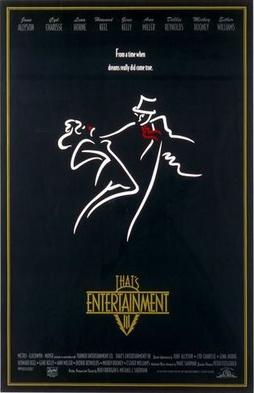
That's Entertainment! III is a 1994 American documentary film released by Metro-Goldwyn-Mayer to celebrate the studio's 70th anniversary. It was the third in a series of retrospectives that began with the first That's Entertainment! (1974) and That's Entertainment, Part II (1976). Although posters and home video packaging use the title without an exclamation mark, the actual on-screen title of the film uses it.
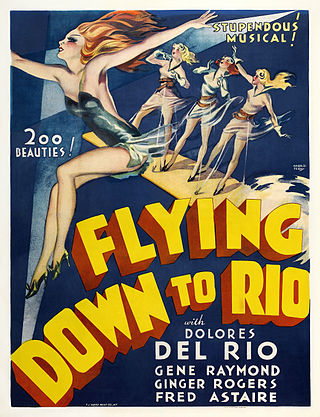
Flying Down to Rio is a 1933 American pre-Code RKO musical film famous for being the first screen pairing of Fred Astaire and Ginger Rogers, although Dolores del Río and Gene Raymond received top billing and the leading roles. Among the featured players are Franklin Pangborn and Eric Blore. The songs in the film were written by Vincent Youmans (music), Gus Kahn and Edward Eliscu (lyrics), with musical direction and additional music by Max Steiner. During the initial year that a Best Original Song was given during 7th Academy Awards, the film obtained a nomination for MUSIC (Song) – "Carioca," Music by Vincent Youmans; Lyrics by Edward Eliscu and Gus Kahn [came in 3rd]. Ironically, the song lost to "The Continental" from The Gay Divorcee, the subsequent film of Fred Astaire and Ginger Rogers after Flying Down to Rio.
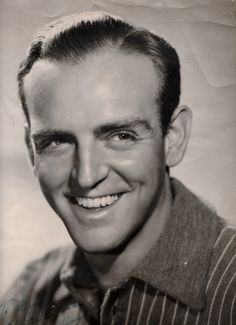
Hermes Pan was an American dancer and choreographer, principally remembered as Fred Astaire's choreographic collaborator on the famous 1930s movie musicals starring Astaire and Ginger Rogers. He worked on nearly two dozen films and TV shows with Astaire. He won both an Oscar and an Emmy for his dance direction.

Follow the Fleet is a 1936 American RKO musical comedy film with a nautical theme starring Fred Astaire and Ginger Rogers in their fifth collaboration as dance partners. It also features Randolph Scott, Harriet Hilliard, and Astrid Allwyn, with music and lyrics by Irving Berlin. Lucille Ball and Betty Grable also appear, in supporting roles. The film was directed by Mark Sandrich with script by Allan Scott and Dwight Taylor based on the 1922 play Shore Leave by Hubert Osborne.
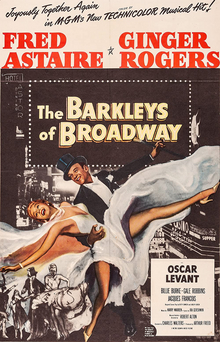
The Barkleys of Broadway is a 1949 American Technicolor musical comedy film from the Arthur Freed unit at Metro-Goldwyn-Mayer that reunited Fred Astaire and Ginger Rogers after ten years apart. Directed by Charles Walters, the screenplay is by Betty Comden, Adolph Green, and Sidney Sheldon, the songs are by Harry Warren (music) and Ira Gershwin (lyrics) with the addition of "They Can't Take That Away from Me" by George and Ira Gershwin, and the choreography was created by Robert Alton and Hermes Pan. Also featured in the cast were Oscar Levant, Billie Burke, Jacques François and Gale Robbins. It is the last film that Astaire and Rogers made together, and their only film together in color. Rogers came in as a last-minute replacement for Judy Garland, whose frequent absences due to a dependence on prescription medication cost her the role.

Ginger and Fred is a 1986 comedy/drama film directed and written by Federico Fellini and starring Marcello Mastroianni and Giulietta Masina.
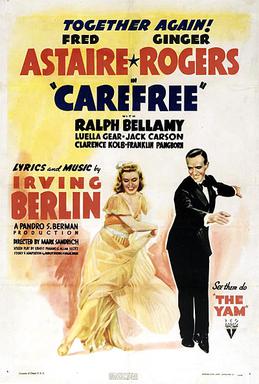
Carefree is a 1938 musical film starring Fred Astaire and Ginger Rogers. With a plot similar to screwball comedies of the period, Carefree is the shortest of the Astaire-Rogers films, featuring only four musical numbers. Carefree is often remembered as the film in which Astaire and Rogers shared a long on-screen kiss at the conclusion of their dance to "I Used to Be Color Blind," all previous kisses having been either quick pecks or simply implied.

Shall We Dance, released in 1937, is the seventh of the ten Fred Astaire-Ginger Rogers musical comedy films. The story follows an American ballet dancer (Astaire) who falls in love with a tap dancer (Rogers); the tabloid press concocts a story of their marriage, after which life imitates art. George Gershwin wrote the symphonic underscore and Ira Gershwin the lyrics, for their second Hollywood musical.

Reeling is Pauline Kael's fifth collection of movie reviews, covering the years 1972 through 1975. First published in 1976 by Little Brown, the book is largely composed of movie reviews, ranging from her famous review of Last Tango in Paris to her review of A Woman Under the Influence, but it also contains a longer essay entitled "On the Future of Movies" as well as a book review of The Fred Astaire & Ginger Rogers Book, by fellow The New Yorker dance critic Arlene Croce. In 2010, four film critics polled by the British Film Institute listed Reeling among their favorite books related to cinema.

Roberta is a 1935 American musical film by RKO starring Irene Dunne, Fred Astaire, Ginger Rogers, and Randolph Scott. It was an adaptation of the 1933 Broadway musical Roberta, which in turn was based on the novel Gowns by Roberta by Alice Duer Miller. It was a solid hit, showing a net profit of more than three-quarters of a million dollars.

Claire Luce was an American stage and screen actress, dancer and singer. Among her few films were Up the River (1930), directed by John Ford and starring Spencer Tracy and Humphrey Bogart in their feature film debuts, and Under Secret Orders, the English-language version of G. W. Pabst's French-language feature, Salonique, nid d'espions (1937).

Fred Astaire and Ginger Rogers were dance partners in a total of 10 films, nine of them with RKO Radio Pictures from 1933 to 1939, and one, The Barkleys of Broadway, with MGM in 1949, their only color film.
In Person is a 1935 romantic musical comedy film starring Ginger Rogers and George Brent.
Rhapsody is a one-act ballet choreographed by Frederick Ashton to Rachmaninoff's Rhapsody on a Theme of Paganini. The ballet was made for both Queen Elizabeth The Queen Mother's 80th birthday, and Mikhail Baryshnikov's guest appearance with the Royal Ballet. It premiered on 4 August 1980, at the Royal Opera House, with the two principal roles danced by Baryshnikov and Lesley Collier. The ballet is dedicated to the Queen Mother.

The Ginger Rogers filmography lists the film appearances of American actress Ginger Rogers, as well as her television, stage, and radio credits. Rogers's career spanned fifty-seven years, from 1930 to 1987.